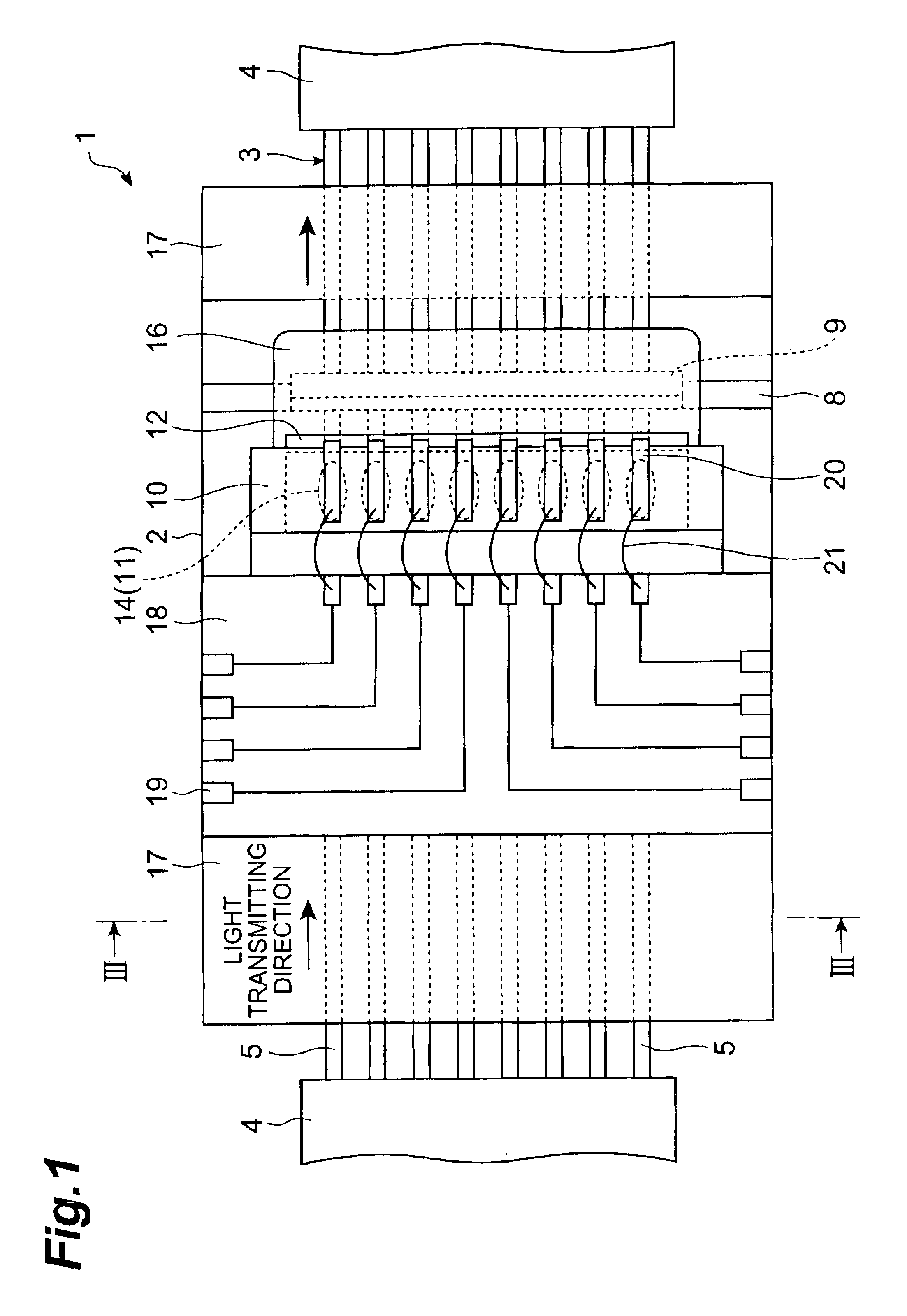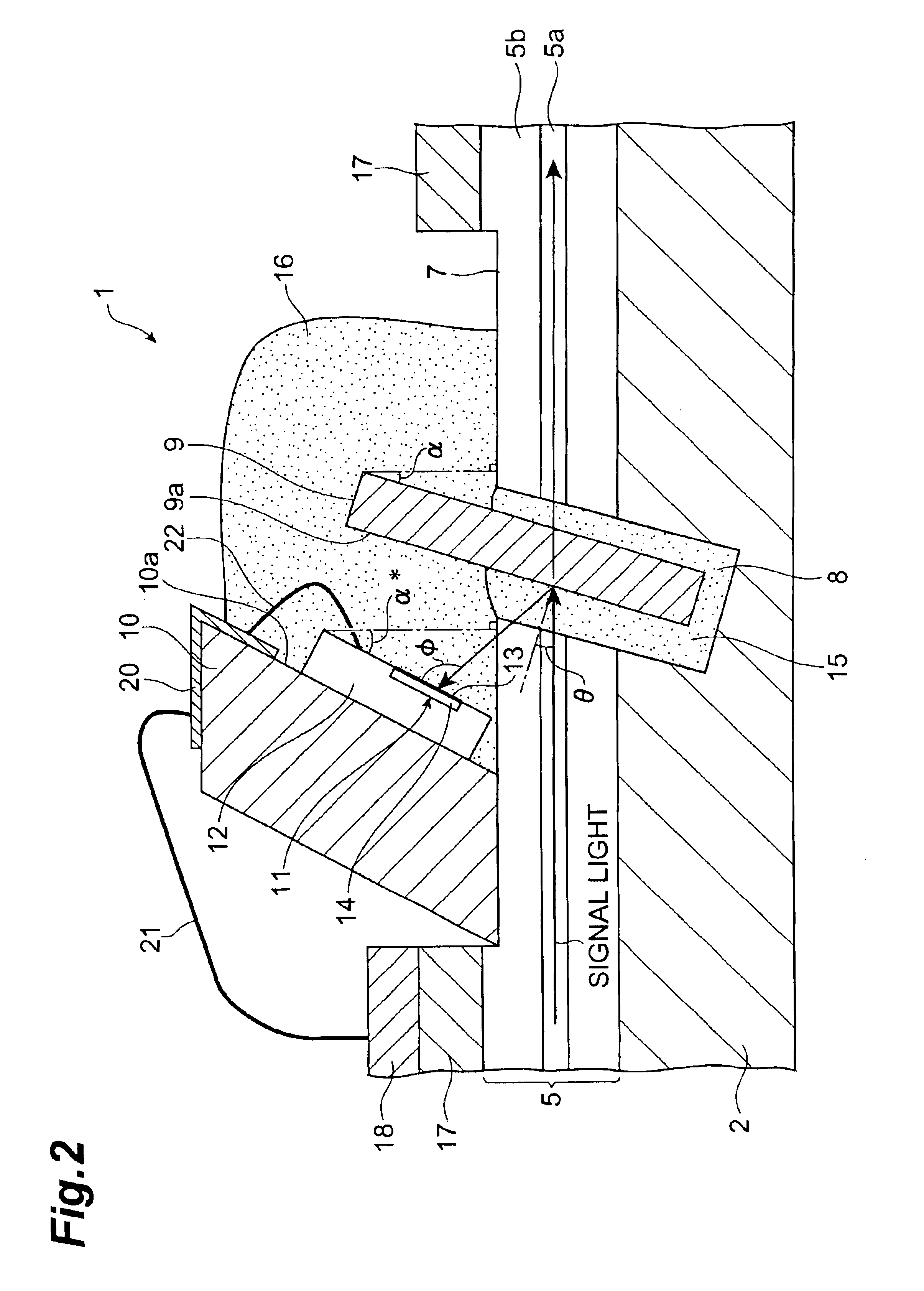Optical device
a technology of optical devices and optical components, applied in the direction of optical elements, semiconductor lasers, instruments, etc., can solve the problems of difficult to accurately monitor the optical intensity of the optical signal, the difficulty of the reflected light on the light entrance surface of the photodetector, etc., to prevent the optical characteristics of the photodetector from deteriorating, stabilize the operation of the photodetector, and improve the reliability of the optical device
- Summary
- Abstract
- Description
- Claims
- Application Information
AI Technical Summary
Benefits of technology
Problems solved by technology
Method used
Image
Examples
first embodiment
FIG. 1 is a plan view showing the optical device in accordance with the present invention, whereas FIG. 2 is a vertical sectional view showing a part of the optical device. In FIGS. 1 and 2, the optical device 1 in accordance with this embodiment comprises a substrate 2, whereas a plurality of bare fibers 5 exposed from a multicore (eight-core here) coated optical fiber tape 3 by removing a coating 4 from its middle part are secured to an upper face part of the substrate 2. As shown in FIG. 3, the upper face of the substrate 2 is formed with a plurality of fiber-positioning V grooves 6, whereas the bare fibers 5 are secured to the substrate 2 by an adhesive or the like while in a state arranged in their respective V grooves 6.
Each bare fiber 5 is constituted by a core 5a and a cladding 5b disposed thereabout. The bare fiber 5 secured onto the substrate 2 includes a cladding-shaved part 7 formed by shaving the upper side of the cladding 5b toward the central axis of the bare fiber 5....
second embodiment
In FIG. 4, the optical device 30 in accordance with the second embodiment has a lid 17 covering bare fibers 5, whereas the lid 17 is provided with a tilted surface 17a inclined with respect to the upper face of a substrate 2. A support member 31 having a rectangular parallelepiped form is mounted on the tilted surface 17a. A photodetector array 12 having a plurality of photodetectors 11 is attached to one side face (support surface) 31a of the support member 31. As a consequence, the light entrance surface 13 of each photodetector 11 tilts by a desirable angle with respect to the upper face of the substrate 2.
Such an optical device 30 uses the rectangular parallel piped support member 31 having a simple structure, and thus is advantageous in terms of manufacturing. Since such a support member 31 is not disposed on the bare fibers 5 but on the lid 17, the bare fibers 5 are hardly damaged upon attaching the photodetectors 11, whereby the increase of loss in the bare fibers 5 can be re...
third embodiment
In FIG. 5, the optical device 40 in accordance with the third embodiment has a cladding-shaved part 7 formed by shaving the upper part of claddings 5b of bare fibers 5. The cladding-shaved part 7 is formed only on the photodetector 11 side of an optical member 9. On the upper face part of the substrate 2, a lid 17 covering the bare fibers 5 is disposed at the location excluding the cladding-shaved part 7. A transverse groove 8 in which the optical member 9 is inserted is formed so as to extend from the upper face of the lid 17 toward the lower side of the substrate 2. A support member 41 is secured to the lid 17. The support member 41 has a support surface 41a tilted by a desirable angle with respect to the upper face of the substrate 2, whereas a photodetector array 12 having a plurality of photodetectors 11 is attached to the support surface 41a.
Since the length of the cladding-shaved part 7 in the bare fibers 5 is minimized while the support member 41 is not secured onto the bar...
PUM
 Login to View More
Login to View More Abstract
Description
Claims
Application Information
 Login to View More
Login to View More - R&D
- Intellectual Property
- Life Sciences
- Materials
- Tech Scout
- Unparalleled Data Quality
- Higher Quality Content
- 60% Fewer Hallucinations
Browse by: Latest US Patents, China's latest patents, Technical Efficacy Thesaurus, Application Domain, Technology Topic, Popular Technical Reports.
© 2025 PatSnap. All rights reserved.Legal|Privacy policy|Modern Slavery Act Transparency Statement|Sitemap|About US| Contact US: help@patsnap.com



